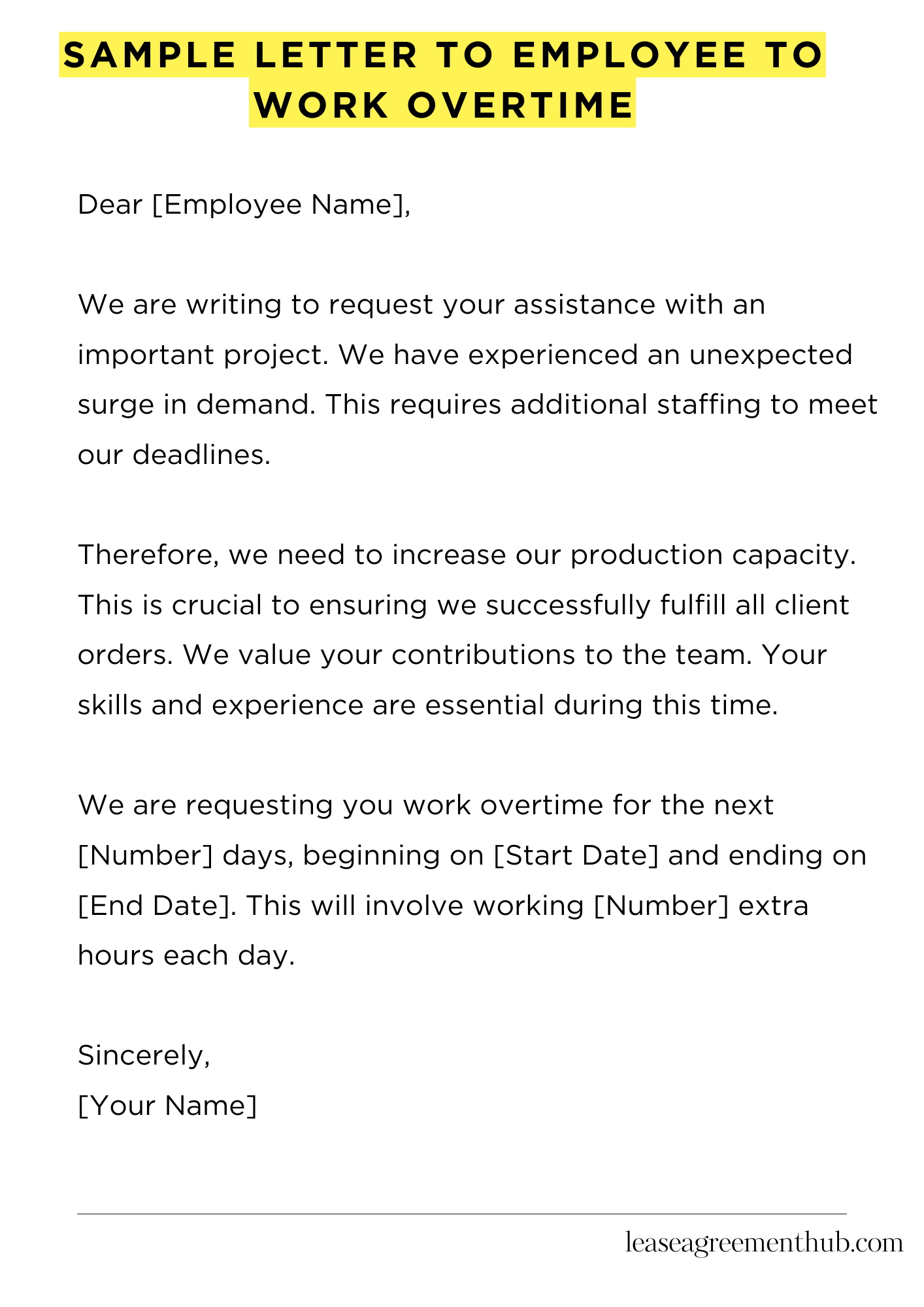Need to ask an employee to work overtime? A sample letter makes it easy. It clearly states the request and necessary details.
This article gives you several examples. Use them as templates. Adapt them to your specific needs.
These samples will help you write a professional request quickly. Save time and effort. Get started now!
Sample Letter to Employee to Work Overtime
[Your Company Letterhead]
[Date]
[Employee Name]
[Employee Address]
Dear [Employee Name],
We are writing to request your assistance with an important project. We have experienced an unexpected surge in demand. This requires additional staffing to meet our deadlines.
Therefore, we need to increase our production capacity. This is crucial to ensuring we successfully fulfill all client orders. We value your contributions to the team. Your skills and experience are essential during this time.
We are requesting you work overtime for the next [Number] days, beginning on [Start Date] and ending on [End Date]. This will involve working [Number] extra hours each day. The overtime hours will be compensated at a rate of [Overtime Rate], as per your employment contract. You will be working on [Brief Description of Project].
Please let us know by [Response Deadline] if you are available to work these extra hours. We understand this is a significant request. Your prompt response will be greatly appreciated. We value your dedication and flexibility. We will work with you to ensure any potential difficulties are addressed.
We will provide you with a detailed schedule shortly. If you have any questions or concerns, please do not hesitate to contact [Your Name] at [Your Phone Number] or [Your Email Address].
Thank you for your hard work and understanding. We appreciate your commitment to our team’s success.
Sincerely,
[Your Name]

How to Write a Sample Letter to Employee to Work Overtime
The Preamble: Setting the Stage for Your Request
Begin your letter with a courteous salutation, addressing the employee formally and respectfully. Avoid overly familiar language; professionalism is paramount. Clearly state the purpose of your correspondence upfront – this isn’t the time for circumlocution. A concise opening sets the tone for a streamlined request. Efficiency is key.
Articulating the Need: Why Overtime is Necessary
This section requires meticulous detail. Explain the exigent circumstances necessitating overtime. Be specific. Instead of vague pronouncements, use concrete examples. Perhaps an unforeseen project deadline looms, or a critical system malfunction necessitates immediate remediation. Provide context without obfuscation.
Quantifying the Request: Specifying Hours and Compensation
Ambiguity breeds resentment. Clearly state the required number of overtime hours. Equally crucial is outlining the compensation structure. Will overtime be paid at a premium rate, or will compensatory time off be offered? Transparency fosters employee goodwill. This is non-negotiable for legal compliance.
Incentivizing Compliance: Offering Added Value
While mandatory overtime is sometimes unavoidable, incentivizing participation can mitigate potential disgruntlement. This could involve offering a bonus, providing additional training opportunities, or promising preferential treatment in future work assignments. Consider the employee’s individual needs and aspirations.
Legal Considerations: Navigating Employment Law
Ensure your request adheres to all pertinent labor laws and company policies regarding overtime. Consult with your HR department to ensure compliance. Ignoring legal stipulations could lead to significant repercussions. Due diligence is paramount.
Closing with Professionalism: Maintaining a Cordial Tone
Conclude your letter with a polite closing remark. Reiterate your appreciation for the employee’s dedication and willingness to consider the request. Thank them for their time and consideration. A professional tone leaves a lasting positive impression, even when the request involves additional work.
Review and Refinement: Ensuring Clarity and Conciseness
Before sending the letter, meticulously review the document for any grammatical errors or ambiguities. Ensure the language is precise and the message is crystal clear. Proofreading is not an optional step; it’s a professional imperative. A well-crafted letter demonstrates respect for both the employee and the process.
FAQs about sample letter to employee to work overtime
Requesting overtime from employees requires careful communication. A well-crafted letter ensures clarity and professionalism.
What information should be included in an overtime request letter?
A comprehensive overtime request letter should include the employee’s name, the date, the specific reason for the overtime, the required dates and times, the overtime pay rate (if different from regular pay), and a clear indication of whether the overtime is mandatory or voluntary. It’s also helpful to include contact information for questions or concerns.
How formal should the tone of the letter be?
The tone should be professional yet considerate. While maintaining a businesslike approach, it’s beneficial to express appreciation for the employee’s flexibility and willingness to contribute beyond their scheduled hours. Avoid demanding language and focus on collaboration.
Is it necessary to offer compensation for overtime work?
Yes, compensation for overtime work is usually legally mandated, and it’s crucial to clearly state the compensation terms in the letter. This includes specifying the overtime rate (often time and a half or double time), as well as how and when the payment will be processed.
What if an employee declines the overtime request?
Respect the employee’s decision if they decline the overtime request, provided it’s not a mandatory requirement tied to a critical operational need. Maintain a professional and understanding attitude, acknowledging their response and thanking them for their consideration.
Are there any legal considerations when requesting overtime?
Yes, adherence to local labor laws regarding overtime pay, maximum working hours, and proper notification is essential. Familiarize yourself with the relevant regulations to ensure compliance and avoid potential legal issues. Seeking legal advice if uncertain about specific requirements is advisable.
Related: